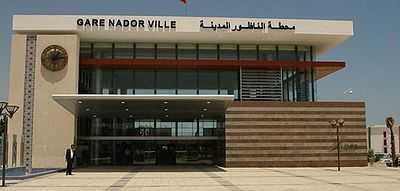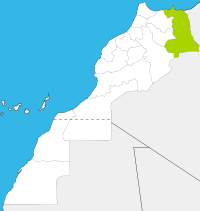Nador
Nador
| |
|---|---|
| City | |
 Nador Location in Morocco | |
| Coordinates: 35°10′N 2°56′W / 35.167°N 2.933°W | |
| Country |
|
| Region | Oriental |
| Province | Nador |
| Government | |
| Elevation | 138 ft (42 m) |
| Population (2013) | |
| • City | 160,000 |
| • Metro | approx. 250,000 |
| • Ethnicities | Berbers: 98%; Spaniards: 1%; Other foreigners: 1% |
| Time zone | WET (UTC+0) |
| • Summer (DST) | WEST (UTC+1) |
| Website | Moroccan official website |
Nador (Berber: ⴻⵏⵏⴰⴹⵓⵔ, Ennaḍor; Arabic: الناظور) is a city located in the northeastern Rif region of Morocco. The city is a Mediterranean port on the Bḥar Ameẓẓyan lagoon (Mar Chica in Spanish), and it is the major trading center in the region for fish, fruit, and livestock. It is linked to the Spanish city of Melilla, 10 kilometers (6.2 mi) to the north, by a semi-motorway. The city has a population of about 150,000 inhabitants.
The Nador province is populated by a Riff-Berber population of more than 600,000 inhabitants. Nador city became the administrative center of the province in 1956.
Overview

The economy of the Nador city and the province of Nador includes fishery, agriculture, some light and heavy industry. The economy has grown dramatically in recent years, particularly due to the manufacturing sector with the building of a metal processing complex supplied with iron ore from the Rif's Wiksan mountain, anthracite from Jerada, textiles, chemicals and some electronics industries.[1]
In the summer months huge numbers of Moroccan nationals originating from the Nador area and living in Europe visit the city. The numbers of these annual visitors/tourists could easily exceed 250,000 total in the three summer months Jun-Jul-Aug. They mainly stay with relatives, buy or rent apartments, rather than staying in Nador's hotels. These visits give a tremendous boost to the city's economy.
Trade is also an important economic sector in the city. The location of the city on the Mediterranean coast and close to the Spanish exclave Melilla are catalysts for international trade.
Nador was infamous as a centre of smuggling cheap Spanish and Chinese duty-free goods. Currently the smuggling has declined but it still alive competing with a smuggling stream from Algeria. Many used consumer goods from Europe and China find their way to Morocco and Africa via Melilla and Nador, both legally and illegally. The goods range from conserved food, clothes, shoes, electric home appliances, up to sophisticated hardware.[2][3]
Nador transmitter
Near Nador is the transmission site for long- and short-wave Medi 1 Radio which broadcasts to all Maghreb countries. The aerial masts of Medi 1 Radio for long-wave are approximately 380 metres high and are among the tallest man-made structures in Africa.
Nador city's main neighborhoods
Main Nador city quarters and neighbourhoods include:
- El Khettabi (El Xeṭṭabi)
- El Kindy (El-Kindi)
- Laarasi (Laɛraṣi)
- Anafag / Elmatar / New Nador / Ennaḍur Amaynu (الناظور الجديد)
- Laari Shikh (Laɛri n Eccix)
- Ammas n Temdint / Centro / Centre ville (Downtown Nador)
Downtown Nador: a relatively developed area in comparison with the rest of the city. This lies in the centre of the city and was partially developed during the Spanish occupation of northern Morocco.
- Ulad Mimun (Ayt Mimun)
- Isebbanen
- Ichumay (Icumay)
- Aarrid (Ɛarriḍ)
- Ulad Barhim
- Tireqqaâ / Tireqqaɛ
- Ayt Leḥsen
- Erfid / Ibarraqen
Transport

- see also Nador Railway stations, Nador International Airport and Nador Port
A railway linking Nador to Taourirt was opened on 2 July 2009 by king Mohammed VI of Morocco.[4][5] as part of ONCF's rail projects. Previously, there was a connecting bus link from Taourirt, also operated by railway company ONCF[6]
In addition, several direct bus links operate between Nador and major Moroccan cities. Daily ferry services link Nador Port with Almeria in Spain and a weekly service to Sète in France.
Nador International Airport offers direct flights to Moroccan and European destinations, effectively serving as Melilla second airport for Air Europa.
Several standard roads give access to the Fes-Oujda expressway (under construction) and to the Spanish exclave of Melilla.
And from neighbouring Melilla you can either take ferries to mainland Spain via Almeria and Málaga and the Melilla airport connects to Madrid, Málaga, Almeria and Granada in Spain.
Tourism
During the summer months, Nador is visited by hundreds of thousands of Moroccan migrants living in Europe, who are originating from the province or from the city of Nador itself. These summer visitors contribute strongly to the development of the city, by buying property, helping their families, and by stimulating the overall local trade and tourism. The local government also wants to attract foreign tourists, and for this reason they try to give the city a better look: cafés have been told to use metal or wooden chairs outside (and not plastic ones), houses have to be painted in appropriate colours throughout the city, and the main boulevard along the sea has been redeveloped and widened. Until early 2008 the city end of the boulevard was formed by the Rif Hotel, but in the spring of 2008 the existing hotel was demolished and the road alongside the boulevard opened and extended. This new road by-passes the city centre and runs directly towards the main roundabout at the entrance of Nador via the Road to Tawima. The remaining grounds where the hotel and its facilities were located is being redeveloped into a new hotel complex: after some delay the new hotel development is being built under supervision of Khalid El Adouli.[7] The new Rif complex is being built on the grounds of the former hotel minus the strip land directly on the coast as this is now a road and a public boulevard, which is on reclaimed land[8][9] The new hotel will be target the high-end tourism market and also cater for business users with congress-facilities. Once re-opened it will (again) offer a discothèque (serving alcoholic beverages) and congres or party rooms. The hotel itself will offer 110 4**** rooms, including 10 suites and also 76 apartment rooms. The budget for the redevelopment of the hotel is 356 Million Dirham and the total usable floorspace will be 30.000 m²[10]
Just outside Nador a new ecological resort is being developed Abdouna Trifa including holiday homes, a golf course and a marina. The total size of the new resort consists of 720.000 m² built area on a terrain of 480 hectare. The start of this 10 year development plan was done in 2008 by Mohammed VI, the King of Morocco[11] Both this project as well as the new RIF Hotel are being developed by CGI: Compagnie Générale Immobiliere, an activity of the CDG Group.[12]
When completed the resort will consist of approx. 1700 "villas", 1300 apartments, a 4* and a 5* hotel. The development also includes a 27 hole golf-track and several other tourist facilities.[13][14]
External links and references
- Nador News; www.nadornews24
- ↑ Morocco. Dorling Kindersley Eyewitness Travel Guides. 2006.
- ↑ Info about Nador and Smuggling visited on 6 May 2008
- ↑ LookLex page on Nador visited on 6 May 2008
- ↑ Le train Nador-Taourirt, enfin sur les rails, FesPub.net.
- ↑ King inaugurates Nador stations
- ↑ Timetables for the bus link can be found on the ONCF website.
- ↑ Profile of Khalid El-Adouli, managing architect of the new Rif hotel development. Visited: 7 September 2012
- ↑ SkyScraper city on the new Rif hotel complex, visited 27 August 2010
- ↑ Artist impression of the NEW Rif hotel, retrieved 26 August 2010
- ↑ Information on hotel redevelopment from RKempo Community site, visited 7 September 2012
- ↑ Press-release of CGI about Start of development Abdouna Trifa (French), 15 July 2008. Downloaded: 7 September 2012
- ↑ Website CGI: Our organisation (French), visited 7 September 2012
- ↑ Photo of building-site information on forum site RKempo.nl about Abdouna Trifa, visited 7 September 2012
- ↑ SkyScraper City on Abdouna Trifa, visited 27 August 2010
Coordinates: 35°10′0″N 02°56′0″W / 35.16667°N 2.93333°W
| |||||||||||||||||
